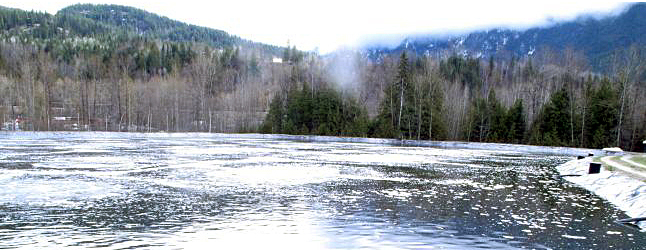
If you live in Southside, particularly in the Powerhouse Road and Oscar Street area, you are doubtless saying “Peewhew!” a lot these days.
Yes, the sewage treatment plant is once again assaulting residents’ noses and it’s going to take money — and a lot of it — to eventually solve it permanently.
“City staff and Council take the odour issue seriously and appreciate the frustration that residents are feeling,” says a statement on the City Hall website Wednesday, July5. “Based on the advice we’ve received and the experiences of our operators, the odour issue is not merely an operational issue; we can’t flip a switch, or expect minor changes to provide long-term improvements to the situation; but this is an issue that will likely require significant capital expenditure.”
“This has been a long-term problem that affects the Southside area mainly during spring and summer months in the evenings. We’ve got two main initiatives happening:
- Operational improvements to add more aeration are underway, but this is expected to be a short term/minor improvement only; and
- Infrastructure planning is in progress to update/review the Liquid Waste Management Plan, which will inform future capacity and treatment upgrades and estimate the timing and expected costs.
Meanwhile, the City has put out a request for proposals from consulting engineers for a study into options and feasibility. This will feed into an update to the Liquid Waste Management Plan (LWMP) process that is required for any changes to our discharge permit.
“This study will likely recommend expansion or replacement of the existing plant, or the construction of a new treatment plant elsewhere to address the aging current infrastructure and development demands,” the statement said. “This process will likely involve further public input to meet provincial requirements, we expect to have a report for Council’s consideration in the early new year.”
It said that “should upgrades prove necessary,” the City will seek external grant funding, to offset costs to utility payers.
The sewage treatment plant, which was built in the 1970s, operates two aerated lagoons with mechanical pre-screening. Generally, the plant relies on bacteria to treat sewage which it helps along with aeration, mixing and occasionally the addition of some chemicals. The plant has undergone numerous upgrades specifically intended to alleviate concerns with odour and treatment effectiveness, the statement said.
“Odour has been an issue on and off for at least twenty years, predominately in the spring and summer months when temperatures increase and atmospheric conditions cause evening inversions,” it said. “The odours are prominent when anaerobic digestion (without oxygen) is occurring. There are many factors influencing why this occurs (see the bottom of this post for a list) and why residents are encountering odours, and addressing the problem has proved difficult.
“One of the challenges is that measuring the success of a change in process or operations can take over two weeks to realize, due to the size of the ponds, by which time the climatic or other conditions may have changed, rendering the validation of the change difficult or impossible. One thing we do know for sure is that aeration and mixing are necessary components and generally our operational changes have been around improving these factors.”
Examples of efforts to combat the odour issue, in the past decade or so include:
- Conversion to fine bubble aeration
- Desludging the first pond
- Addition of ferric chloride dosing at Downie Lift Station
- Inlet Works odour control project
- Periodic dosing the first pond with granular nitrate
- Periodic addition of beneficial bacteria in first pond
- Eliminating some anaerobic waste streams
- Installing mixers in first pond
- Improvements in airflow/cooling in the blower room to increase air output.
- Additional aeration work underway in 2017.
Short list of factors that influence odours:
Inflow
- Biological Oxygen Demand (BOD)
- Total suspended solids
- pH, too acidic can cause anaerobic digestion.
- Total flow
- Temperature
- Grease
- Treatment inhibitors/toxicity
Pond
- Aeration of the pond (Dissolved Oxygen)
- Mixing – Seasonal turn over. It is quite common for aerated lagoons to smell for a week or so in spring and fall.
- Temperature
- warmer temperatures leads to higher treatment rates, requiring more oxygen.
- lower temperatures inhibits treatment, causing sludge build up, which can turn over causing odours when air temperatures increase.
Environment
- Wind and airflow
- Diurnal and seasonal patterns
- Temperature
- Proximity to dwellings
If you’d like to read some of the previous stories about this perennial and smelly municipal issue please enter the words “sewage treatment” into the search function on the front page and then take your pick of the many stories it drags to the surface.



